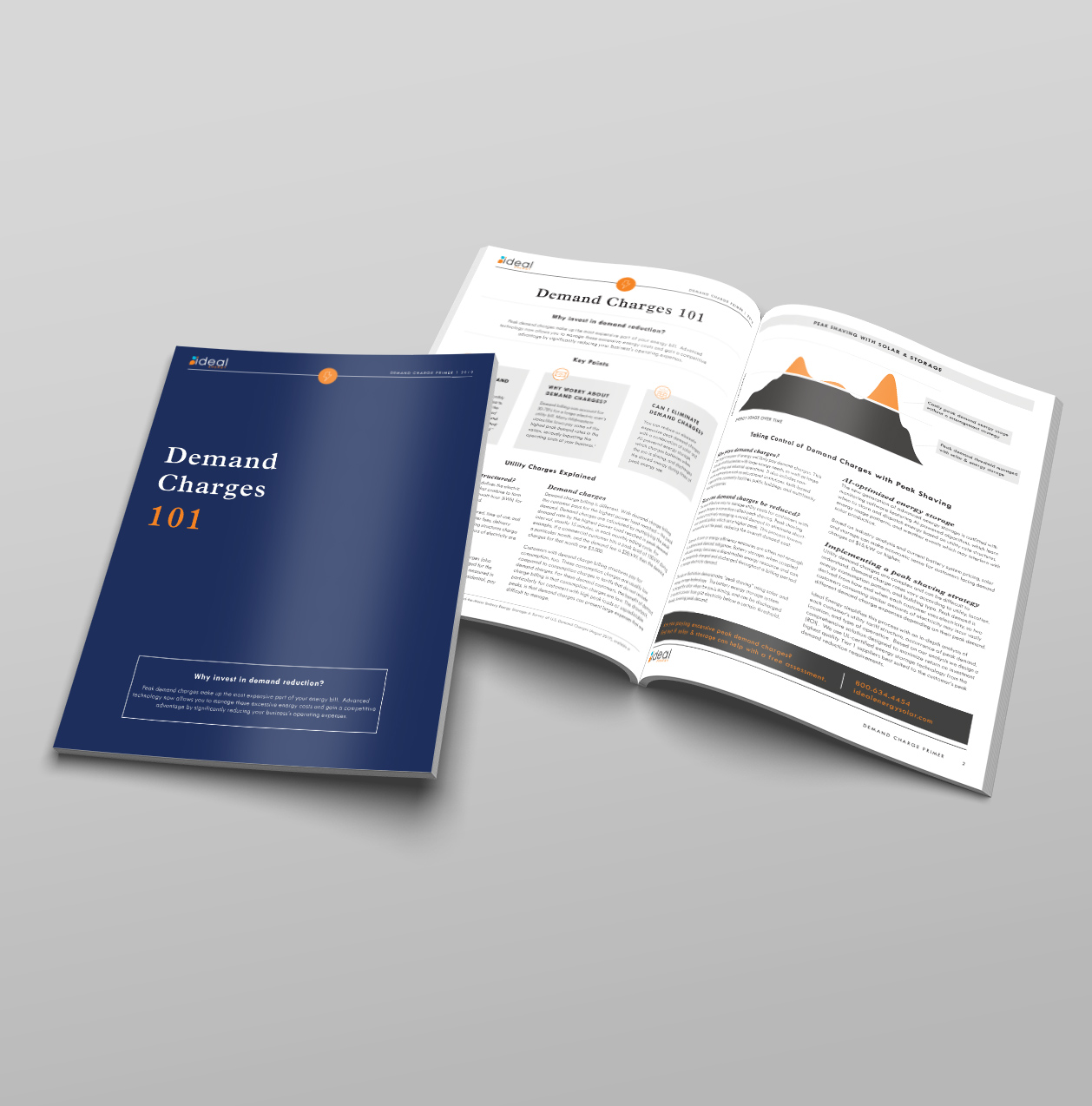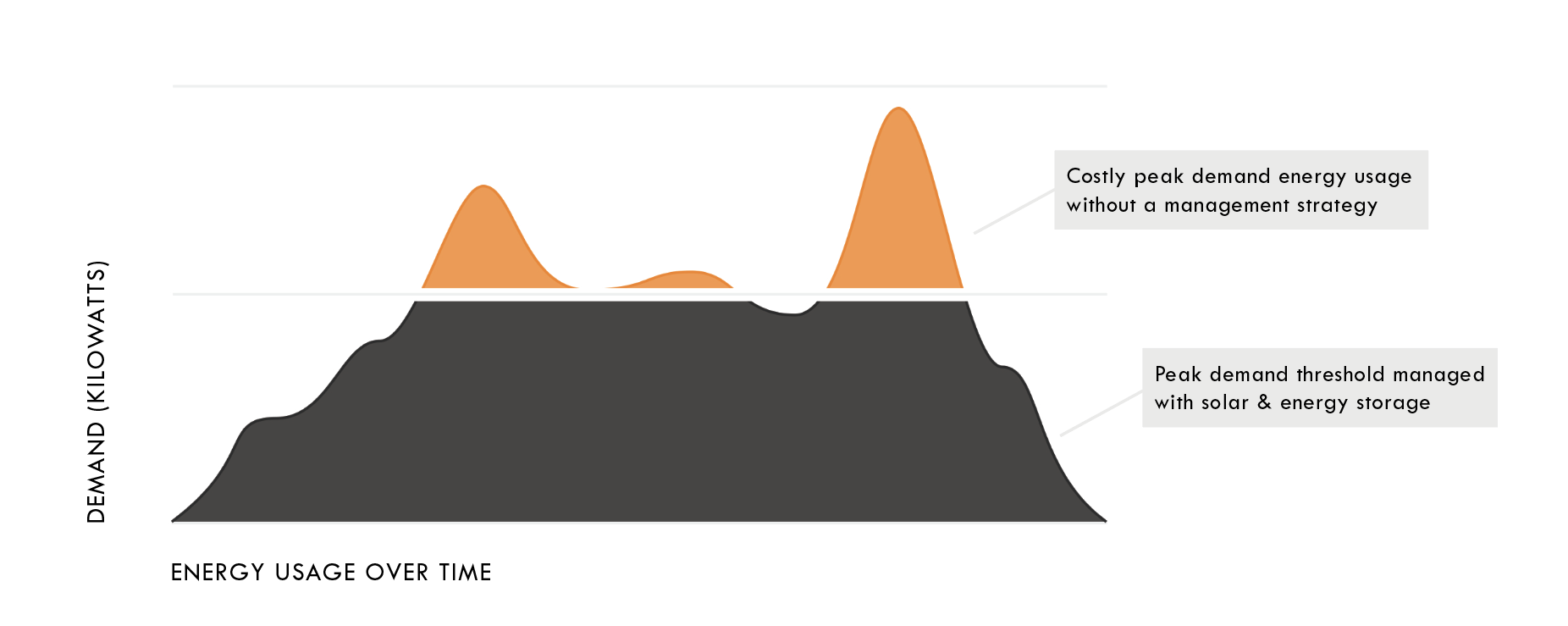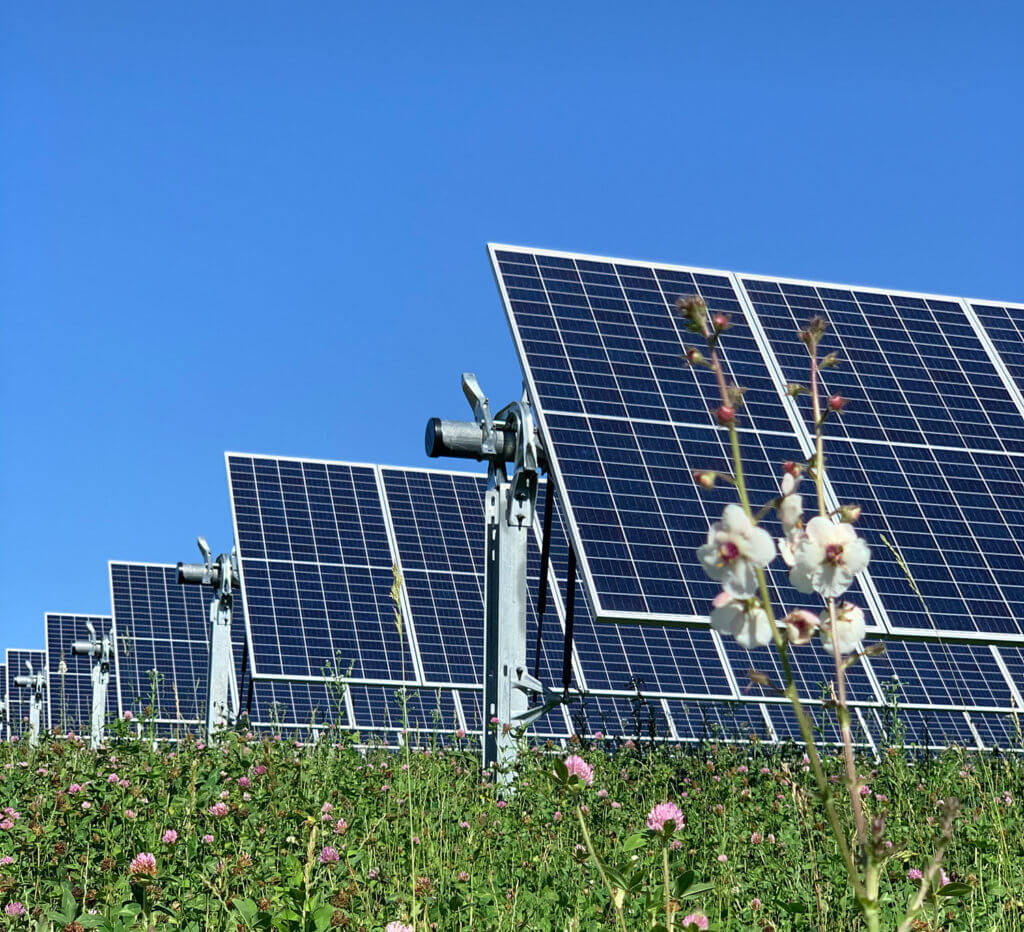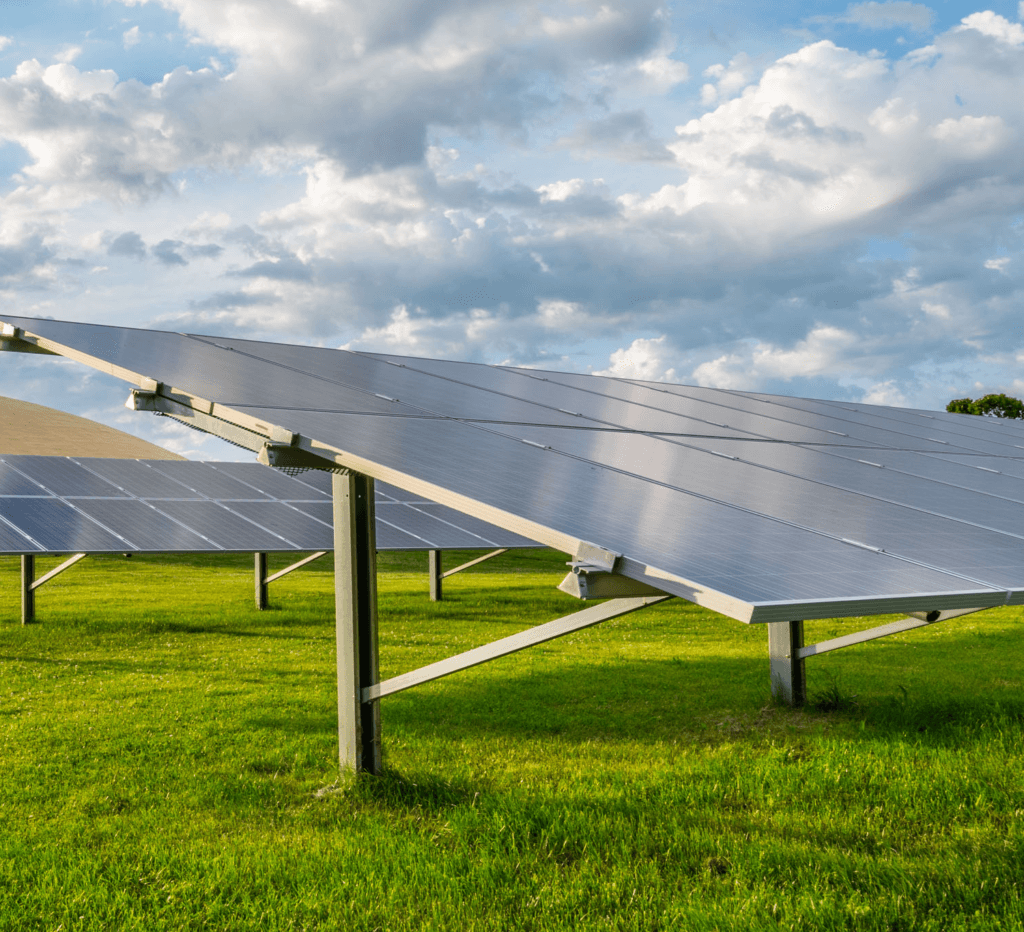Do you use a lot of electricity? You might need peak shaving for more affordable energy.
Advanced technologies to include AI-optimized solar and storage systems now allow you to manage these excessive energy costs and gain a competitive advantage by significantly reducing your business’s operating expenses.
What Are Demand Charges?
The most effective way to manage utility costs for customers with demand charges is a practice called peak shaving. Peak shaving involves proactively managing overall demand to eliminate short-term demand spikes, which set a higher peak. This process lowers and smooths out peak loads, which reduces the overall cost of demand charges.
We believe solar + battery energy storage is the best way to peak shave. Other methods – diesel generators, manually turning off equipment, etc. – all present significant downsides. Battery energy storage systems do not generate pollution or noise, require no employee time to operate, and do not impact business operations. They make solar viable for more customers, which in turn generates additional savings.
WHAT ARE DEMAND CHARGES?
For large electric users, monthly energy bills consist of two parts: 1) Basic energy charges for the total amount of electricity used throughout the billing period and 2) Demand charges for the highest electric usage or “peak demand.”
WHY WORRY ABOUT DEMAND CHARGES?
Demand billing can account for 30-70% for a large electric user’s utility bill. Many Midwestern states like Iowa pay some of the highest peak demand rates in the nation, seriously impacting the operating costs of your business.
CAN I ELIMINATE DEMAND CHARGES?
You can reduce or eliminate expensive peak demand charges with a combination of solar and AI-powered energy storage, which charges batteries when the sun is shining, and discharges the stored energy during times of peak energy use.
How Do Demand Charges Work?
Types of Charges
CONSUMPTION CHARGES
Flat, tiered, and time-of-use structures all charge for consumption only. With each of those billing structures, the customer pays for the kilowatt-hours of electricity used in each billing cycle.
FLAT BILLING
With flat billing there is only one rate for all consumption, regardless of time of time day or total amount of usage. For example, $0.10/kWh.
TIERED BILLING
With tiered billing there are two or more rates for different usage amounts. The first several hundred kWh are billed at one rate, the next several hundred kWh are billed at another rate, and so on. Some utilities charge less as usage increase, while others charge more. For example, $0.10/kWh for the first 500 kWh and $0.08/kWh for all usage beyond the first 500 kWh.
TIME-OF-USE BILLING
With time-of-use billing there are two or more rates depending on the time of day when electricity is consumed. The utility will define on-peak and off-peak times of day based on how much demand occurs during those times. Customers are charged a higher rate during on-peak times. For example, $0.10/kWh from 10:00 AM to 8:00 PM and $0.08/kWh the rest of the day.
These billing structures can become much more complicated. Utilities may combine tiered and time-of-use billing, for example. Some utilities define additional peak levels, like mid-peak and critical peak. The on-peak window may be different during summer and winter, or during weekdays and weekends. Seasonal rates may be overlaid over any of these systems.
DEMAND CHARGE BILLING
Demand charge billing is different. With demand charge billing the customer pays for the highest power load reached – the peak demand. Peak demand is defined as the highest average load during a peak demand interval (usually 15 minutes) in each billing cycle.
The actual demand charge is calculated by multiplying the peak demand rate by the peak demand. For example, if a customer hits a peak load of 150 kW during a particular month, and the demand fee is $10/kW, then the demand charges for that month are $1,500.
Customers with demand charge billing structures pay for consumption, too. Those consumption charges are usually flat or tiered. The consumption electric rate is usually very low compared to the rates in consumption-only tariffs.
Two customers with similar overall consumption could have very different bills depending on the size of their peak loads and when they occur.
RATCHET CLAUSES
Some demand charge tariffs contain a characteristic known as a ratchet clause. Ratchet clauses impose a minimum demand charge throughout the year based upon a fraction of the highest peak demand. Ratchet causes can make demand charges even more significant, particularly for customers with seasonal load profiles.
For example, a ratchet clause might charge a customer 75% of their overall annual peak every month of the year. If that customer hit 100 kW peak demand in July, they would be charged for at least 75 kW of demand during the other 11 months of the year regardless of how high their peaks actually are during those months.
Why Do Demand Charges Exist?
Supply and Demand: Matching Generation with Base Load and Peak Load
Utilities need to balance their generation capacity with their customers’ demand for electricity at all times. However, customer demand isn’t constant; it varies from the peak load down to the base load.
The peak load is the highest overall system load the utility reaches. The base load is the lowest level of load. Utilities use several strategies to balance supply with these different levels of load. The traditional approach is a combination of unvarying power plants and dispatchable generation. Other options include buying and selling electricity with long-term contracts, buying and selling electricity on the energy spot market, and curtailment.

Download our guide to demand charge mitigation
How Demand Charges Fit In
Demand charges pass the higher marginal cost of peaker plants and load following plants on to consumers. In theory, they also mitigate the need for more of these plants by sending price signals to customers to reduce their demand during peak times.
Utility Methods of Power Supply for Peak Demand
UNVARYING POWER PLANTS
Unvarying power plants provide base load generation. These plants typically run at full capacity all the time. They usually only power down for maintenance. They therefore tend to have a high capacity factor, which is the ratio of actual output to theoretically possible output. They also tend to have low marginal operating costs, but high fixed costs and construction costs. They usually can’t be modulated much, if at all, in response to demand.
Nuclear plants and coal-fired plants are often used as unvarying power plants. Nuclear plants have the highest capacity factor of any generation modality and among the lowest marginal costs. Coal plants also have low marginal costs. Both are difficult to start, stop, and modulate, so it makes sense to run them continuously. Hydroelectric, geothermal, fuel oil, combined cycle, and other types of power plants can also be used for base load. Solar and wind can be used for base load if paired with energy storage.
DISPATCHABLE GENERATION
The chief characteristic of dispatchable generation is the ability to modulate generation in response to changes in demand.
PEAKING POWER PLANTS
Peaking power plants, or peaker plants, operate in conjunction with unvarying base load power plants. They are relatively cheap to build and have short start up and shut down times, but they have higher marginal costs than unvarying power plants. Because peaker plants sit idle some of the time yet need to be staffed and ready to power up on short notice, they are costlier to operate than unvarying plants. Natural gas turbine plants and hydroelectric plants are often used as peaker plants.
LOAD FOLLOWING POWER PLANTS
Load following plants fall in between base load plant and peaker plants in terms of capacity factor, fixed costs, marginal costs, and startup and shutdown times. They are still considered dispatchable, they just aren’t quite as responsive as peaker plants.
Load Profiles
Types of Load Profiles
DAILY LOAD PROFILE
Daily load profiles have variations in demand within each day, but most days are similar to one another. A grocery store that operates seven days a week, but shuts down at night, would likely have a daily load profile.
SEASONAL LOAD PROFILE
A seasonal load profile has variations in demand from season to season that overshadow any daily or weekly differences. Customers with heavy air conditioning loads have seasonal load profiles. A university or office that air conditions lots of space would likely have a seasonal load profile.
WEEKLY LOAD PROFILE
A weekly load profile has little variation in demand throughout a single day, but more variation from one day to another. A manufacturer that operates 24 hours a day, but closes on the weekend, would have a weekly load profile.
Peak Shaving
Traditional Methods of Peak Shaving
MANUAL INTERVENTION
The most straightforward and least reliable method is to manually manage demand. For example, a plant manager could power down certain machines during the on-peak window. These techniques can work, but they’re not foolproof. A single mistake on one day could bring about a very expensive power bill for the month.
CONTROLLERS
A similar, but more reliable method is to use controllers programmed to prevent certain machines from turning on when power demand is already high during the on-peak window. The downside to controllers is that they may require customers to choose between expensive demand charges and running machinery when it makes business sense to do so.
DIESEL GENERATORS
Diesel generators can be used to manage demand charges by providing additional energy during on-peak times, reducing the need to draw from the grid. However, generators have several significant downsides. They are costly to operate if used frequently, both in terms of fuel and in terms of wear and tear. Generators also pollute and they are loud.
STANDALONE SOLAR
Standalone solar arrays reduce electricity consumption very well and they can be used to mitigate demand charges to an extent, but they can’t provide guaranteed peak shaving. Cloud cover or shading can temporarily reduce solar generation and hamper the effectiveness of peak shaving.
The New Energy Frontier: Peak Shaving With Solar & Battery Energy Storage
Sophisticated control software with learning algorithms differentiates battery energy storage systems from regular batteries. These algorithms learn a customer’s load profile, anticipate peak demand, and switch from the grid to batteries when needed most.
Battery energy storage systems can guarantee that no power above a predetermined threshold will be drawn from the grid during peak times. They can automatically detect when power usage exceeds a pre-determined threshold and switch from the grid or solar panels to batteries until the additional demand is over. When demand goes back down the batteries recharge. For a deeper explanation of these systems see our previous article in this series, How Battery Energy Storage Systems Work.

There are many types of energy storage systems commercially available including lithuium-ion, lithium-iron, and flow batteries. The Ideal Energy design and engineering team specialize in analyzing load profiles, energy needs, and designs custom peak-shaving solar + energy storage solutions.
According to the NREL and Clean Energy Group, solar + storage makes economic sense for millions of customers in dozens of states.

Above: Agri-Industrial Plastics Company of Fairfield is Iowa’s first advanced manufacturing operation to implement a demand reduction plan by peak saving with solar enesgy and Tesla Powerpack energy storage.
Battery Energy Storage FAQ
Does Battery Energy Storage Work Without Solar?
Yes. You don’t need a solar array to take advantage of many of the benefits that these systems offer. Peak shaving, load shifting, and emergency backup are examples of applications that work just fine without a solar array. Of course, solar is required for off-grid homes, solar self-consumption, and renewable energy microgrids.
Yes. Modern battery energy storage systems are incredibly safe. They’re accredited to international safety standards and will operate safely even in extreme conditions. Unlike old flooded lead-acid batteries, these batteries don’t vent explosive hydrogen into the air. They’re designed to be water-resistant, dustproof, and tolerant of a wide range of temperatures. They can be mounted indoors or outside. There are no exposed wires or hot vents. They’re touch-safe and pet and kid-friendly.








